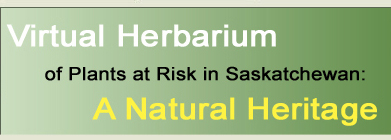
|

|

|

|

|

|

|
|
|
|
|
|
| Lomatium dissectum var. multifidum (Nutt.) Mathias & Constance | Species Image Gallery (opens in a new window) |
||||||||||||||||||||||||||||
| TAXONOMY | |||||||||||||||||||||||||||||
| Family: | Apiaceae | ||||||||||||||||||||||||||||
| Genus: | Lomatium | ||||||||||||||||||||||||||||
| Species Synonyms: | Lomatium dissectum var. eatonii
(Coult. & Rose) Cronq. Leptotaenia multifida Nutt. |
||||||||||||||||||||||||||||
| Common Names: | carrotleaf biscuitroot | ||||||||||||||||||||||||||||
| DISTRIBUTION | |||||||||||||||||||||||||||||
| Canada: | British Columbia, including Vancouver Island - southwestern Alberta, southeastern Alberta - southwestern Saskatchewan | ||||||||||||||||||||||||||||
| Saskatchewan: | southwestern Saskatchewan; Cypress Hills | ||||||||||||||||||||||||||||
| Ecoregion: | Cypress Hills Upland | ||||||||||||||||||||||||||||
| HABITAT | |||||||||||||||||||||||||||||
| Saskatchewan: | fine soils, north-facing slopes, forested areas in dominated by aspen, lodgepole pine, or white spruce | ||||||||||||||||||||||||||||
| RARITY STATUS | |||||||||||||||||||||||||||||
| Provincial
Status According to Harms (2003): |
Threatened |
||||||||||||||||||||||||||||
| Nature Conservancy Status: | G4T4 S1 |
||||||||||||||||||||||||||||
| Saskatchewan
Species at Risk Status: |
None |
||||||||||||||||||||||||||||
| COSEWIC Status: | None |
||||||||||||||||||||||||||||
| Carrotleaf biscuitroot is threatened in Saskatchewan because it is extremely rare and regionally restricted in the province. No immediate threats are known but are possible in the future. | |||||||||||||||||||||||||||||
| SPECIES DESCRIPTION | |||||||||||||||||||||||||||||
| Height: | 3 - 15 dm tall. | ||||||||||||||||||||||||||||
| Roots: | taproot short, knobby, spindle-shaped | ||||||||||||||||||||||||||||
| Stems: | ridged, hairless, straw colored; rarely absent | ||||||||||||||||||||||||||||
| Leaves: | alternate; sheathing; 15 – 40 cm long, 10 – 30 cm wide; deltoid to orbicular; divided into threes then 2 – 4 time pinnate; upper leaf surface hairless; veins and margin on underside of leaf with short, firm hairs | ||||||||||||||||||||||||||||
| Leaflets: | ultimate divisions 2 – 20 mm long, linear | ||||||||||||||||||||||||||||
| Inflorescence: | umbel compound; bracts to 1 cm long; rays 10 - 20, 4.5 – 5.5 cm long | ||||||||||||||||||||||||||||
| Umbellets: | bractlets strongly reflexed, linear to lance-shaped; fruiting stalks 0.4 - 2 cm in var. multifidum; flowers 20 – 40 | ||||||||||||||||||||||||||||
| Flowers: | ~ 2 mm long, yellowish or dark purple, some sterile | ||||||||||||||||||||||||||||
| Fruits: | schizocarp, to 1.2 cm long, 6 – 10 mm wide, elliptic, light colored, hairless; styles persistent; lateral wings thick and corky, narrower than seed-bearing body, oil tubes obscure, flattened | ||||||||||||||||||||||||||||
| |||||||||||||||||||||||||||||